Services on Demand
Journal
Article
Indicators
-
 Cited by SciELO
Cited by SciELO -
 Access statistics
Access statistics
Related links
-
 Similars in
SciELO
Similars in
SciELO
Share
Revista internacional de contaminación ambiental
Print version ISSN 0188-4999
Rev. Int. Contam. Ambient vol.30 n.3 Ciudad de México Aug. 2014
Translocation of heavy metals in Zea mays L. treated with wastewater and consequences on morphophysiological aspects
Translocación de metales pesados en Zea mays L. tratado con aguas residuales y efectos en aspectos morfofisiológicos
Ahmad Najib KOBAISSI1,2*, Ali Ahmad KANSO2 and Hussein Jaafar KANBAR2
1 Department of Plant Biology and Environment, Research and Analysis Platform for Environmental Sciences. Lebanese University. *Corresponding author; ahkobeissi@ul.edu.lb
2 Doctoral School of Sciences and Technology, Research and Analysis Platform for Environmental Sciences, Lebanese University
Received June 2013;
accepted June 2014
ABSTRACT
Utilization of treated wastewater has become an alternative for crop irrigation due to freshwater scarcity. For that reason, a pot experiment was conducted using treated wastewater from a Lebanese wastewater treatment plant as an irrigation source to study the effect on the physical and morphophysiological performance of Zea mays L. Treatments with 50 % wastewater showed superior characteristics for some of the plant's features, such as leaf area, plant dry mass, nitrate reductase activity and chlorophyll content; while those treated with 100 % wastewater negatively affected the plant's growth. Cadmium was the only metal that was mostly accumulated in the leaf for all treatments, while other metals were accumulated in the roots (Na and Fe), stem (Zn and K) or in either root or leaf according to concentration of wastewater. Major elements to the plant, such as sodium and potassium were highly accumulated in the plants treated with 50 and 100 % wastewater, nevertheless, metals were also accumulated (order: Fe > Cu > Cd > Zn), but at lower amounts, and only cadmium content in the plant is considered harmful to feeding livestock, while zinc is considered potentially harmful. Finally, proper irrigation with wastewater can boost plant's growth, and therefore can be used as an alternative of traditional irrigation.
Key words: leaves, metal, physiology, roots, stem, wastewater, corn.
RESUMEN
El uso del agua residual tratada para irrigar los cultivos se ha vuelto una alternativa común debido a la escasez de agua dulce. Por esa razón, en este trabajo se presentan los resultados de un experimento en el que se utilizó el agua proveniente de una planta de tratamiento de agua residual libanesa, como fuente de riego, para estudiar los efectos en el desempeño físico y morfofisiológico de Zea mays L. Los tratamientos con 50 % de agua residual mostraron características superiores para algunos rasgos de la planta, como el área foliar, el peso seco, la actividad de la nitrato reductasa y el contenido clorofílico, mientras que aquellas tratadas con el 100 % de agua residual, mostraron efectos negativos en su crecimiento. El cadmio resultó ser el único metal que fue almacenado principalmente en la hoja para todos los tratamientos, mientras que otros metales se acumularon en las raíces (Na y Fe), en el tallo (Zn y K) o en la raíz u hoja, dependiendo de la concentración del agua residual. Los elementos importantes para las plantas, como el sodio y el potasio se encontraron en grandes concentraciones en las plantas tratadas con 50 y l0o % de agua residual, sin embargo, algunos metales también se almacenaron (en el siguiente orden: Fe > Cu > Cd > Zn), pero en cantidades menores. Únicamente el contenido de cadmio en la planta es considerado dañino si se consume, mientras que el zinc es potencialmente dañino. Finalmente, una irrigación apropiada con agua residual puede promover el crecimiento de la planta y, por tanto, puede ser utilizada como una alternativa al riego tradicional.
Palabras clave: hojas, metales, fisiología, raíces, tallo, aguas residuales, maíz.
INTRODUCTION
The increasing demand for freshwater, especially in arid and semi-arid regions, has led to the usage of alternative irrigation sources, for the population is in constant augmentation. One of those alternatives is the usage of treated municipal wastewater. Nevertheless, irrigation with wastewater should be thoroughly thought of before taken into action, since wastewater contains elements that may alter the normal growth of plants, such as pathogens, heavy metals and other pollutants (Gupta et al. 2008, Simmons et al. 2010), those elements are able to alter the biological processes (Ikehata et al. 2009, Palese et al. 2009, Weldesilassie et al. 2011) and physicochemical characteristics of the soil (Angin et al. 2005, Segal et al. 2011, Tripler et al. 2011) and cause over-fertilization of crops, and thus reduce crop resistance (Hamilton et al. 2007). Yet, treatment with wastewater is capable of improving soil fertility, and as a result boost crop production (Rusan et al. 2007, Pereira et al. 2011). For those reasons, this experiment was conducted to investigate the extent of heavy metal translocation in Zea mays irrigated with treated wastewater; to detect heavy metal concentrations in both treated wastewater and maize, and compare them with standard limits; and lastly to assess the impact of treated wastewater on the physical and morphophysiological characteristics of Z. mays.
MATERIALS AND METHODS
Plant pot system and plant growth
A pot experiment of twelve randomized PVC columns, three treatments and four replicates, was conducted in the Plant Biology and Environment Department of the Lebanese University. Each PVC column, of 15 cm diameter, was filled with a 40 cm layer of air-dried and 7 mm meshed clay loam soil. A subsample of the soil was used to determine chemical and physical properties. Each treatment was irrigated with 500 mL/week on two steps, the three treatments consists of three irrigation solutions: T1: 1:0, T2: 1:1 and T3: 0:1 of potable-water:wastewater (v:v). The wastewater used here was brought from Al-Ghader station (Lebanon) where only preliminary treatment had taken place.
In each pot, three pre-germinated seeds were sown in the soil at a depth of 2 cm. One week after planting, only the most viable plant was kept in each pot. During the whole period of the experiment (forty-two days), environmental conditions were controlled. A twelve hour photoperiod, 21 °C temperature and 50-60 % humidity were set. Plants were sacrificed 42 days after planting. Leaf number and plant height were recorded, fresh weight of the roots, shoots and leaves, separately, were taken. In addition, dry weight (DW) of roots, stems and leaves was determined after drying at 80 °C in an oven till no more mass was lost. The plant DW and shoot to root ratio was calculated. The leaf area was determined by image analysis software (Image-Pro Plus v4.5; Media Cybernetic, Bethesda, MD, USA). Specific leaf area (SLA in cm2/g), leafmass ratio (LMR), stem mass ratio (SMR) and root mass ratio (RMR) were calculated according to Hunt (1990). The nitrate reductase activity (NRA) was measured following the method adopted by Jaworski (1971). Total chlorophyll content of the leaves was determined via spectrophotometer (thermo 115 spectronic), and calculations were concluded according to Arnon (1949).
Metal analysis
The initial soil sample was mixed, dried and sieved with a 2 mm sieve. It was tested for heavy metal content. 0.5 g of each sample were microwave-acid digested (Speedwave, MWS-2 microwave-system, BERGHOF) with 1:3 volumes of HNO3:HCl (aqua regia). As for the solutions used for irrigation in each treatment, 2-3 drops of 65 % HNO3 were added to each sample prior to metal analysis. Heavy metal analysis (Cd, Cu, Fe, Pb, Zn) was done by atomic absorption spectrophotometer (AAS) (RayleiGh-WFX-210). Cation analysis (Na+ and K+) of the soil and irrigated solutions was done by flame photometry (Sherwood - model 420).
As for metal detection in plant parts, 0.5 g of the dried plant material were microwave-acid digested with 7 mL of HNO3 (65 %) and 1 mL of H2O2 (30 %). The heavy metals in the various parts of the plants were analyzed using AAS, and sodium and potassium ions were analyzed by flame photometer.
Statistical analysis
Statistical analyses were performed using SPSS statistics 17.0. Data were subjected to analysis of variance (ANOVA) at P < 0.05 and P < 0.01, Duncan's multiple range test (a = 5 %) and Pearson's correlation coefficient.
RESULTS
Concentration of heavy metals in the soil and irrigation solutions
The results indicate that all the elements' concentrations in the wastewater are below the maximum permissible limit (MPL), except for Cd concentration (Table I).
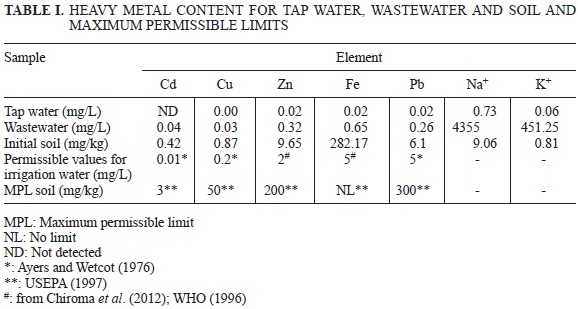
Growth and plant quality
All the corns grew throughout the experiments regardless of the type of irrigation, however 100 % wastewater irrigation (T3) reduced plant height (from 127 and 128 cm, in T1 and T2 respectively, to 90 cm), leaf area and plant dry weight; the last two are significantly affected (Table II). As for corn irrigated with 1:1 tap water:wastewater (T2), some showed superior characters, though not significant, such as plant height, leaf area and plant dry weight. Shoot and root dry weights were significantly different between T2 and T3. The greatest variation between all treatments was shown on the shoot/root dry weight ratio (or total plant dry weight), where the dry weight of the shoot was lower than that of the root solely in T3.
Fig. 1 shows the variation of the plant part's growth with respect to the whole plant. The RMR showed significant increase when treated with higher concentrations of wastewater (0.36, 0.38 and 0.56 for T1, T2 and T3 respectively) on one hand, and higher ratios when compared to leaf and stem mass ratios on the other, while the other parts, i.e. stem and leaves showed opposite relation as to the first, with higher impact on the outcome of the stem growth. As for the specific leaf area, it only showed a significant increase between T1 and those treated with different concentrations of wastewater (T2 and T3).

Nitrate reductase activity increased from T1 to T2 to T3, but on a non-significantly basis (120, 126 and 132 nmol NO2/g/h respectively) (Fig. 2a). On the other hand, results show that chlorophyll content increased significantly (P < 0.05) when treated with 50 or 100 % wastewater (Fig. 2b), and T2 and T3 treatments had as much as twice total chlorophyll content than T1.
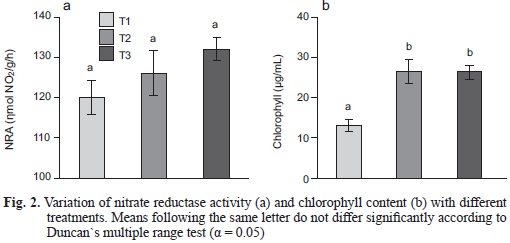
Metal accumulation in corn parts
The mean concentration of cadmium (Cd) was mostly found to be accumulated in the leaf parts of the maize, whereas lowest concentrations were found in the stem for T1 treatment and root for T2 and T3 ones (Fig. 3). Regarding the Cd concentration in the whole plant, it followed the order of T3 > T2 > T1 (1.016 > 0.932 > 0.862 mg/kg), as did Zn, Na and K (Table III). Copper on the other hand, when treated with 50 or 100 % wastewater showed lower concentrations in the root when compared to T1 treatments, and possible complexations of copper had taken place that made it less likely to be absorbed by the roots. Zinc and potassium were found in amounts several folds higher in the stem than in the other two parts. Iron was greatly absorbed by the root treated with 50 % wastewater (T1: 57.11 < T2: 103.11 mg/kg), nonetheless it decreased in T3 to 70.64 mg Fe/kg. As for sodium, it showed highest values in the root in T2 and T3 treatments. Regarding the three treatments, Zn, Fe, Na and K followed significantly different behaviors (Fig. 3). As for metal concentrations in the whole plant, cadmium was detected in amounts greater than permissible limits in all treatments (Table III). T1 and T2 treatments contained zinc a few mg/Kg below the limit, however T3 was slightly above it.
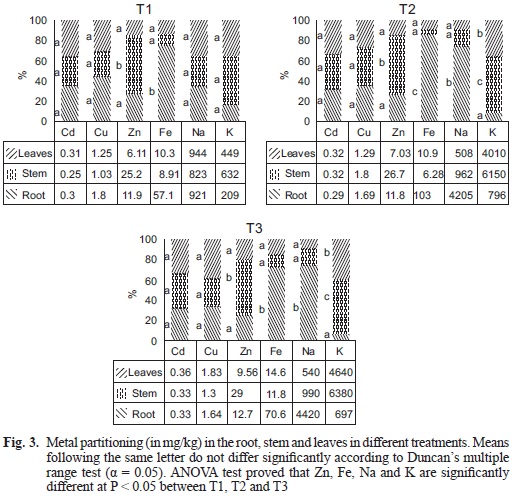
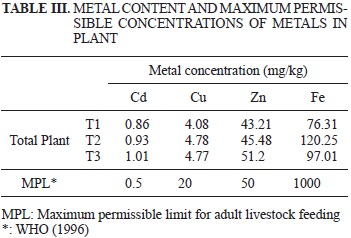
The mean metal content of each plant was computed per total dry weight (Fig. 4). In general, dry matter produced through T2 and T3 treatments were found to contain higher metal concentrations than T1. Sodium and potassium content of T2 and T3 were significantly higher (P < 0.05) than T1 (Fig. 4a and b). While for the rest (Cu, Fe, Cd and Zn), treatments associated with wastewater contained higher concentrations, though not significant (Fig. 4c-f). Therefore, element contents in the plants were the highest in T3, followed by T2 and lastly T1. Potassium was the highest element to be accumulated from T1-T2 (548.03 %), while zinc was the lowest (0.53 %) (Table IV). T2-T3 metal accumulation, however, witnessed sodium as the highest accumulation, while iron was the lowest. The degree of accumulation in T1-T2 is: K > Na > Fe > Cu > Cd > Zn, T1-T3 follows the same order, while T2-T3 showed a different one (Na > K > Zn > Cu > Cd > Fe).
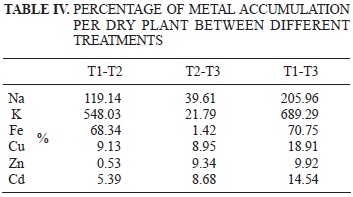
Pearson's correlation showed the presence of certain correlations between different metals on one hand, and different plant physical features on the other (Table V). Fe and K, Zn and Cu, Cd and Cu and Cd and Zn proved to be positively correlated at a = 0.01 (r = 0.919, 0.929, 0.945 and 0.983 respectively), while sodium and potassium and iron shared a correlation significant at a = 0.05. Nonetheless, all relations seemed to be positively correlated, opposing Na content in the plant and S/R ratio (r = -0.850). As for the physical features, shoot dry weight was strongly correlated with all other physical features, indicating its vulnerability to other changes that are caused by the usage of wastewater as irrigation.
DISCUSSION
The irrigation solutions used in this experiment, whether pure wastewater, tap water or the 50 % mix, contain elements below the permissible limit, except the high Cd content in wastewater (Table I). Besides that, they are generally suitable for irrigation. Irrigation with wastewater reduced plant growth by reducing plant height, dry weight (root and shoot), shoot to root ratio and leaf area (Table II). Previous works have also reported the effects of wastewater irrigation on the growth of several ornamental shrubs, the response observed was species dependent (Chaiprapat and Sdoodee 2007, Gori et al. 2008). In our case, decreased plant growth was due to the high salinity content ofthe wastewater, sodium being the major saline ion (Table I). Corn shoot growth was more sensitive to wastewater than root growth (Table II and Fig. 1), where shoot dry mass was found, only in T3 case, to be less than root dry mass. The same result was observed in Polygala shoot growth (Banon et al. 2011). Also, Niu and Rodriguez (2006) observed a decline in S/R when herbaceous perennials were irrigated with saline water. When the wastewater was diluted (i.e. T2), the resulting water had higher organic matter and nutrient content than tap water treatments, for this reason, a slight amelioration in plant growth was obtained in T2 treatments (Chaiprapat and Sdoodee 2007). Regarding the S/R ratio, mixed water reduced the effect of wastewater in corn, since irrigation with this water resulted in a greater leaf area than the other two treatments. Chaiprapat and Sdoodee (2007) found that Chinese green mustard plants treated with an effluent blend had a higher leaf area than those in the control, which was associated with both the benefit of nutrients in the effluent and an appropriate dilution. In T2 treatments, a reduction in salt ions, a changed nutrient concentration or an altered nutritional equilibrium could have promoted the plant growth in comparison to T3 treatments. Similar results were reported by Day et al. (1979) who observed that wheat irrigated with treated wastewater produced taller plants and higher grain yields than did wheat grown with pump water alone. When the mass ratio of the leaves, stem and root where calculated, they showed that T1 and T2 treatments were very similar, however when compared to T3 ones, it was shown that the root system was the least to be affected, while the stem was mostly affected. The SLA in T3 showed a higher area with respect to leaf mass, meaning that the thickness of the leaves did in fact diminish when treated with 100 % wastewater. Similarly, Bray and Reid (2002) pointed out the effect of high salinity on the growth of Phaseolus vulgaris. On another note, Esmailian et al. (2011) observed an increase in chlorophyll content in corn with wastewater irrigation, and Bergareche et al. (1994) and Umebese et al. (2009) observed an increased NRA in plants irrigated with wastewater that could attribute to the high nitrate content of the effluent; this was shown in this experiment, where an increase in the chlorophyll content and NRA of plants irrigated with mixed water and wastewater was observed (Fig. 2).
The results in table III and figure 3 indicate that the accumulation of heavy metals was more prominent with increasing the proportions of treated wastewater (the pattern of accumulation follows the order of T1< T2 < T3). The concentrations of Cd, Cu, Zn and Fe in the plant under consideration varied from 0.862 to 1.016, 4.08 to 4.78, 43.21 to 51.2 and 76.31 to 120.25 mg/kg, respectively at different irrigation regimes. Cd reached a level higher that permissible according to WHO, and Zn in T3 treatment was above MPL, while the rest were all below the MPL. Heavy metals present in the effluents used for irrigation tend to accumulate in the soils, become bio-available and eventually get translocated to plants (Toze 2006). Similarly, Shat-anawi (1994) found that heavy metals increased in eggplant fruit and leaves when using treated waste-water irrigation, which confirms the findings that the treated wastewater was also a factor in boosting the heavy metal accumulation in the plant parts (Fig. 4), other researchers also reported an increase in micronutrients uptake by the plant when irrigated with sewage water (Brar et al. 2002, Mohammad and Mazahreh 2003).
The heavy metal accumulation and translocation potential is plant and metal dependent. Moreover, heavy metals in soils occur in complicated forms because of their association with organic and colloidal forms that in turn influence their availability (Li et al. 1995). Some researchers found that the presence ofZn can inhibit Cd adsorption and thereby cause low Cd accumulation in plants, especially in the roots (Adriano 1986, Nan et al. 2002). The results in figures 3 and 4 indicate that corn was able to accumulate a certain amount of Zn. Sharma et al. (2004) also reported that Fe concentration reduced the uptake of metals, particularly Cd. The high concentration of Fe accumulated in the roots of corn may be attributed to the microbial consortium in the roots, which excrete organic acids that facilitate the absorption and accumulation of Fe in the roots, as reported by Crowley et al. (1991). In this study, K accumulated in various parts of the crops. The order of potassium accumulation is stem > leaf > root, and for sodium root > stem > leaf in T2 and T3. Disregarding sodium and potassium accumulation in the plant, Fe and Cu were the highest to accumulate (Table IV), followed by Cu then Zn, Masona et al. (2011) also reported that Fe was the highest metal to accumulate in the corn. Berry et al. (1980) found that heavy metals taken up by vegetables grown with wastewater tend to mostly accumulate in the roots, as is the case of iron, sodium, and copper (Fig. 3), and only a fraction of the heavy elements absorbed is translocated to the top.
Fazeli et al. (1991) provided evidence that the accumulation of heavy metals in different parts of the plant body might be due to the tendency of different parts of the plant to accumulate certain amounts of metals, while Ardakani et al. (1988) reported that plant species and plant parts influence the uptake and accumulation of heavy metals by plants. In this study, a strong and positive correlation was found between cadmium and zinc content in the plant (Table V), Ogbonna and Nwosu (2011) found a same relationship; however it was between cadmium in the plant and zinc in the soil. Nevertheless, the presence of a certain metal in the plant may alter the presence of another.
CONCLUSION
This report clearly shows how maize treated with wastewater decreased its performance, especially plants treated with 100 % wastewater (i.e. T3), where leaf area and total dry weight of were significantly reduced, with higher effect on the shoot than root. Wastewater also boosted the physiological response of Z. mays in terms of leaf area, NRA and total chlorophyll content, the last showed great increase when as much as 50 % wastewater was added. Cadmium was the only metal that was found above MPL in the whole plant in all treatments, and thus can cause a threat to feeding livestock, while Zn content in T3 plants might possibly pose a threat. Zn was mostly found in the stem, Fe in the roots, Na in the roots for plants treated with wastewater and Cd in the leaves and stem. K and Na accumulated the highest in the plant followed by Fe, Cu Cd and Zn. In conclusion, wastewater can be suitable for irrigation if the content of heavy metals and other contents are limited to nondestructive influence, but can cause serious growth deterioration if containing elemental concentrations that prove themselves unconstructive to the plant.
REFERENCES
Adriano D.C. (1986). Trace elements in the terrestrial environment: biogeochemistry, bioavailability, and risks of metals. Springer-Verlag GmbH. New York. 533 pp. [ Links ]
Angin I., Yaganoglu A.V. and Turan M. (2005). Effects of long-term wastewater irrigation on soil properties. J. Sustain. Agr. 26, 31-42. [ Links ]
Ardakani A.F., Corey K.A. and Gouin F.R. (1988). Influence of pH on cadmium and zinc concentrations of cucumber grown in sewage sludge. Hort. Sci. 23, 1015-1017. [ Links ]
Arnon D.I. (1949). Copper enzymes in isolated chlo-roplast. Polyphenoloxidase in Beta vulgaris. Plant Physiol. 24, 1-15. [ Links ]
Ayers R.S. and Wetcot D.W. (1976). Water quality for agriculture. Food and Agriculture Organization of the United Nations. California. 97 pp. [ Links ]
Banón S., Miralles J., Ochoa J., Franco J.A. and Sánchez-Blanco M.J. (2011). Effects of diluted and undiluted treated wastewater on the growth, physiological aspects and visual quality of potted lantana and polygala plants. Scientia Horticulturae 129, 869-876. [ Links ]
Bergareche C., Ayuso R., Masgrau C. and Simon E. (1994). Nitrate reductase in cotyledons of cucumber seedlings as affected by nitrate, phytochrome and calcium. Physiol. Plant. 91, 257-262. [ Links ]
Berry W.L., Wallace A. and Lunt O.R. (1980). Utilization of municipal wastewater for the culture of horticultural crops. Hort. Sci. 15, 169-171. [ Links ]
Brar M.S., Khurana M.P.S. and Kansal B.D. (2002). Effect of irrigation by untreated sewage effluents on the micro and potentially toxic elements in soils and plants. Department of Soils, Punjab Agricultural University, Ludhiana-141 004, Punjab, India. 17th WCSS, Thailand. 198-210. [ Links ]
Bray S. and Reid D.M. (2002). Effects of salinity and CO2 enrichment on the growth and anatomy of the second trifoliate leaf of Phaseolus vulgaris. Can. J. Bot. 80, 349-359. [ Links ]
Chaiprapat S. and Sdoodee S. (2007). Effects of waste-water recycling from natural rubber smoked sheet production on economic crops in southern Thailand. Resour. Conserv. Recy. 51, 577-590. [ Links ]
Chiroma T.M., Ebwele R.O. and Hymore F.K. (2012). Levels of heavy metals (Cu, Zn, Pb, Fe and Cr) in Bushgreen and Roselle irrigated with treated and untreated urban sewage water. Int. Res. J. Environment Sci. 1, 50-55. [ Links ]
Crowley D.E., Wang Y.C., Reid C.P.P. and Szansiszlo P.J. (1991). Mechanism of iron acquisition from sid-erophores by microorganisms and plants. Plant Soil 130, 179-198. [ Links ]
Day A.D., McFadyen J.A., Tucker T.C. and Cluff C.B. (1979). Commercial production of wheat grain irrigated with municipal waste water and pump water, J. Environ. Qual. 8, 403-406. [ Links ]
Esmailian Y., Ghanbari A., Babaeian M. and Tavassoli A. (2011). Influence of organic and inorganic fertilizers and wastewater irrigation on yield and quality traits of corn. Am. Eurasian. J. Agric. Environ. Sci. 10, 658-666. [ Links ]
Fazeli M.S., Sathyanarayan S. and Satish P.N. (1991). Effect of paper mill effluents on accumulation of heavy metals in coconut trees near Ninjangud, Mysore District, Karnataks. J. Envi. Geo. Water Sci. 17, 47-50. [ Links ]
Gori R., Lubello C., Ferrini F., Nicese F.P. and Coppini E. (2008). Reuse of industrial wastewater for the irrigation of ornamental plants. Water Sci. Technol. 57, 883-889. [ Links ]
Gupta N., Khan D.K. and Santra S.C. (2008). An assessment of heavy metal contamination in vegetables grown in wastewater-irrigated areas of Titagarh, West Bengal, India. Bull. Environ. Contam. Toxicol. 80, 115-118. [ Links ]
Hamilton A.J., Stagnitti F., Xiong X., Kreidl S.L., Benke K.K. and Maher P. (2007). Wastewater irrigation: the state of play. Vadose Zone Journal 6, 823-840. [ Links ]
Hunt R. Basic growth analysis. Unwin Hyman Ltd. London. 112 pp. [ Links ]
Ikehata K., Liu Y. and Sun R.N. (2009). Health effects associated with wastewater treatment, reuse, and disposal. Water Environ. Res. 21, 2126-2146. [ Links ]
Jaworski E.G. (1971). Nitrate reductase assay in intact plant tissue. Biochem. Biophys. Res. Commun. 43, 1274-1279. [ Links ]
Li Y.M., Chaney R.L., Schneiter A.A. and Miller J.F. (1995). Genotypic variation in kernel cadmium concentration in sunflower germplasm under varying soil conditions. Crop Sci. 35, 137-141. [ Links ]
Masona C., Mapfaire L., Mapurazi S. and Makanda R. (2011). Assessment of heavy metal accumulation in wastewater irrigated soil and uptake by maize plants (Zea mays L) at Firle Farm in Harare. J. Sust. Dev. 4, 132-137. [ Links ]
Mohammad M.J. and Mazahreh N. (2003). Changes in soil fertility parameters in response to irrigation of forage crops with secondary treated wastewater. Comm. Soil Sci. Plant Anal. 34, 1281-1294. [ Links ]
Nan Z., Li J., Zhang Z. and Cheng G. (2002). Cadmium and zinc interaction and their transfer in soil-crop system under actual field conditions. Sci. Total Environ. 285, 187-195. [ Links ]
Niu G. and Rodriguez D. (2006). Relative salt tolerance selected herbaceous perennials and groundcovers. Sci. Hortic.-Amsterdam 110, 352-358. [ Links ]
Ogbonna P.C., and Nwosu A.N. (2011). Metal concentration in soil and plants in abandoned cement factory. International Conference on Biotechnology and Environment Management (IPCBEE). 18, 146-150. [ Links ]
Palese A., Pasquale V., Celano G., Figliuolo G., Masi S. and Xiloyannis C. (2009). Irrigation of olive groves in Southern Italy with treated municipal wastewater: effects on microbiological quality of soil and fruits. Agr. Ecosyst. Environ. 129, 43-51. [ Links ]
Pereira B., He Z., Stoffella P. and Melfi A. (2011). Reclaimed wastewater: effects on citrus nutrition. Agr. Water. Manage. 98, 1828-1833. [ Links ]
Rusan M.J.M., Hinnawi S. and Rousan L. (2007). Long term effect of wastewater irrigation of forage crops on soil and plant quality parameters. Desalination 215, 143-152. [ Links ]
Segal E., Dag A., Ben-Gal A., Zipori I., Erel R., Suryano S. and Yermiyahu U. (2011). Olive orchard irrigation with reclaimed wastewater: agronomic and environmental considerations. Agr. Ecosyst. Environ. 140, 454-461. [ Links ]
Sharma N.C., Gardea-Torresdey J.L., Parsons J. and Sahi S.V (2004). Chemical speciation and cellular deposition of lead in Sesbania drummondii. Environ. Toxicol. Chem. 23, 2068-2073. [ Links ]
Shatanawi M. (1994). Minimizing environmental problems associated with the use of treated wastewater for irrigation in Jordan. Amman. Water and Environmental Research and Study Center, University of Jordan. 34 pp. [ Links ]
Simmons R.W., Ahmad W., Noble A.D., Blummel M., Evans A. and Weckenbrock P. (2010). Effect of long-term un-treated domestic wastewater reuse on soil quality, wheat grain and straw yields and attributes of fodder quality. Irri. Drain. Syst. 24, 95-112. [ Links ]
Toze S. (2006). Reuse of effluent water benefits and risks. Agric. Water Manage. 80, 147-159. [ Links ]
Tripler E., Shani U., Mualem Y. and Ben-Gal A. (2011). Long-term growth, water consumption and yield of date palm as a function of salinity. Agric. Water Manage. 99, 128-134. [ Links ]
Umebese C.E., Ade-Ademilua O.E. and Olonisakin B.O. (2009). Impact of combined industrial effluent on metal accumulation. Nitrate reductase activity and yield of two cultivars of Vigna unguiculata (L.) Walp. J. Environ. Sci. Technol. 2, 146-152. [ Links ]
USEPA (1997). Exposure factors handbook. Volume II-Food Ingestion Factors. EPA/600//P-95/002Fa. US Environmental Protection Agency. Office of Research and Development. Washington, DC, USA. [ Links ]
Weldesilassie A.B., Boelee E., Drechsel P. and Dabbert S. (2011). Wastewater use in crop production in periurban areas of Addis Ababa: impacts on health in farm households. Environ. Dev. Econ. 16, 25-49. [ Links ]
WHO (1996). Trace elements in human nutrition and health. World Health Organization. Geneva. 361 pp. [ Links ]














